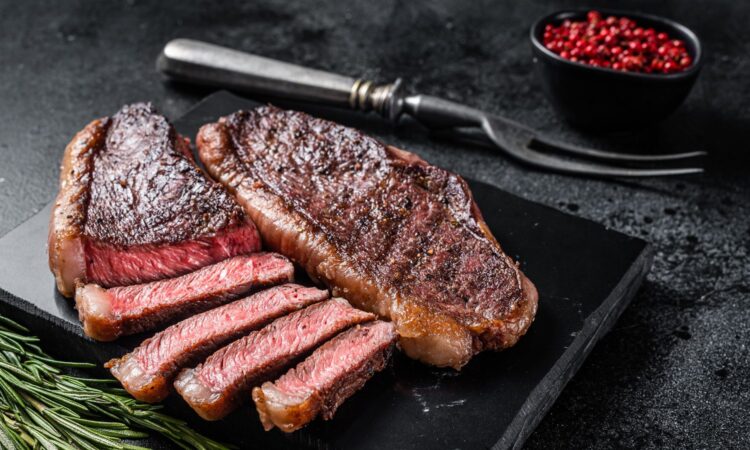Money blog: ‘Seismic shift’ for UK banks, as milestone passed today; is more expensive steak actually better for you? | UK News

It can be hard to balance the demands of eating well without spending a lot.
In this series, we try to find the healthiest options in the supermarket for the best value – and have enlisted the help of Sunna Van Kampen, founder of Tonic Health, who went viral on social media for reviewing food in the search of healthier choices.
In this series we don’t try to find the outright healthiest option, but help you get better nutritional value for as little money as possible.
This time we’re looking at meat.
“When it comes to which type of meat you buy, there’s a common misconception the more expensive the cut the healthier it is,” Sunna says.
“But fatty meat stores more nutrients than their lean counterparts – vitamins like A, D, E, and K are fat-soluble and stored in animal fat – so, a fillet steak may contain less nutrients than its fatty cousin,” he adds.
The science
We typically turn towards leaner cuts of meat due to the common belief that saturated fat from animals is something to be avoided.
“Yet, the latest science suggests that saturated fat and cholesterol may not be as harmful as researchers once thought they were,” Sunna says.
He points to a 2020 review in the National Library of Medicine that looked at several studies on saturated fat and heart disease – and found that the association between the two appeared to be weak.
That being said, a large amount of fat in your diet is in no way advisable – but don’t be afraid to introduce fattier cuts.
Mince
Sunna swears by mincemeat – preferring it to steak if choosing the fattier kind.
Most supermarkets sell somewhere between 5-20% versions – and Sunna urges shoppers to put the higher percentages in their baskets.
“Mince beef with higher fat content isn’t just about the added fat-soluble vitamins; it’s also about what comes with it,” he says.
“The added tendons, ligaments and connective tissue in mince beef provides collagen.”
Collagen is a protein – full of amino acids that supports the structure of your skin, hair, and nails.
It also plays a vital role in maintaining the integrity of your joints and connective tissues.
“By choosing mince beef with 20% fat, you’re getting a broader nutritional profile, including those collagen benefits,” he says.
The money
Using prices from major supermarkets, Sunna compares his the money and the health for major beef products…
- Fillet steak: Around £35/kg, it’s the most expensive cut and doesn’t provide as many health upsides as other, cheaper options
- Ribeye steak: Around £24/kg, with added fat that offers more fat-soluble vitamins.
- Rump steak: Around £15/kg, it’s one of the most economical ways to steak and that nice rind of fat will give you the added nutrition.
- Steak mince beef 5% fat: Around £7/ kg, it’s premium mince but at over half the price of steak, making a great affordable option, but the lower fat content is only really good for reducing the calories.
- Mince beef 20% fat: Priced at about £5/kg, it’s one of the most affordable options that gives you the most health upside – with all the added fat-soluble vitamins, omega 3s and collagen.
“Swapping a fillet steak a week to 20% mince could save you £182.52 a year and you’d be increasing your nutrition intake considerably,” Sunna says.
“Not only does mince beef save you money, but it also provides a versatile base for countless dishes – burgers, meatballs, bolognese, tacos -the possibilities are endless.”
Organics and grass-feds
“Whilst all unprocessed meat is healthy, there are benefits to the quality of your meat,” Sunna continues.
“Typically, a local grass-fed cut of meat has higher omega-3 fatty acids which are beneficial for heart and brain health – up to 6x more in fact than feed-lot cattle,” he adds.
These can often be far more expensive, however.
“Choosing between fillet steak and mince beef doesn’t have to be a battle of indulgence versus health – both have their unique nutritional benefits, but when it comes to a cost-effective, nutritious option, mince beef with 20% fat takes the win,” he says.
The nutritionist’s view, from Dr Claire Shortt, lead scientist at FoodMarble…
While it’s fine to consider cheaper cuts of beef over say filet mignon, it’s best to moderate red meat intake given potential links to certain cancers.
Processed meats are more problematic again, especially from a bowel or stomach cancer perspective. In fact, the World Health Organisation classifies them as a Class I carcinogen (i.e. “known to cause cancer”).
Read more from this series…






